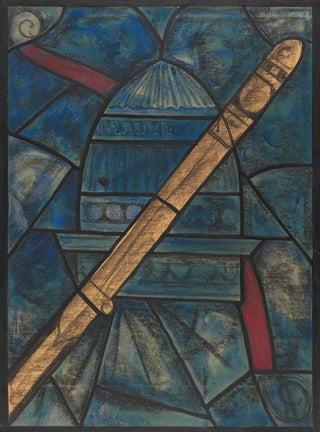Art print | Window project in the north transept of the Dom Tower in Utrecht 31 - Richard Nicolas Roland Holst


View from behind

Frame (optional)
In a world where art and architecture meet in a sublime way, the art print of "Projet de fenêtre dans le transept nord de la tour Dom à Utrecht 31" by Richard Nicolas Roland Holst stands out as a compelling testament to the harmony between light and structure. This piece, both technical and poetic, evokes spirituality and the grandeur of religious buildings. Through this work, Holst does not merely design a simple decorative element; he creates a true sensory experience, where every detail is crafted to dialogue with the surrounding architecture. The window thus becomes a symbol of communion between the sacred and the profane, inviting the viewer to introspective contemplation.
Style and uniqueness of the work
Richard Nicolas Roland Holst's style is distinguished by an innovative approach that combines tradition and modernity. In "Projet de fenêtre dans le transept nord de la tour Dom à Utrecht 31," the artist employs floral and geometric motifs inspired by medieval stained glass, while infusing them with a contemporary dynamism. The chosen colors, both vivid and nuanced, play with natural light, creating shadows and clarity that transform the interior space. The work is characterized by a fluidity of forms, where each element seems to flourish in an organic movement. This singularity allows the art print to transcend time, offering multiple readings that renew with each glance. Holst thus manages to capture the very essence of spirituality through a rich and evocative visual language.
The artist and his influence
Richard Nicolas Roland Holst is an emblematic figure of Dutch art of the early 20th century, whose influence endures to this day. Trained within a dynamic artistic context, he successfully integrated Symbolist and Art Nouveau currents into his work, while developing a unique personal sensitivity. Holst dedicated part of his career to exploring the relationship between man and his environment, seeking to establish a dialogue between nature and architecture. His work, marked by a profound

Matte finish

View from behind

Frame (optional)
In a world where art and architecture meet in a sublime way, the art print of "Projet de fenêtre dans le transept nord de la tour Dom à Utrecht 31" by Richard Nicolas Roland Holst stands out as a compelling testament to the harmony between light and structure. This piece, both technical and poetic, evokes spirituality and the grandeur of religious buildings. Through this work, Holst does not merely design a simple decorative element; he creates a true sensory experience, where every detail is crafted to dialogue with the surrounding architecture. The window thus becomes a symbol of communion between the sacred and the profane, inviting the viewer to introspective contemplation.
Style and uniqueness of the work
Richard Nicolas Roland Holst's style is distinguished by an innovative approach that combines tradition and modernity. In "Projet de fenêtre dans le transept nord de la tour Dom à Utrecht 31," the artist employs floral and geometric motifs inspired by medieval stained glass, while infusing them with a contemporary dynamism. The chosen colors, both vivid and nuanced, play with natural light, creating shadows and clarity that transform the interior space. The work is characterized by a fluidity of forms, where each element seems to flourish in an organic movement. This singularity allows the art print to transcend time, offering multiple readings that renew with each glance. Holst thus manages to capture the very essence of spirituality through a rich and evocative visual language.
The artist and his influence
Richard Nicolas Roland Holst is an emblematic figure of Dutch art of the early 20th century, whose influence endures to this day. Trained within a dynamic artistic context, he successfully integrated Symbolist and Art Nouveau currents into his work, while developing a unique personal sensitivity. Holst dedicated part of his career to exploring the relationship between man and his environment, seeking to establish a dialogue between nature and architecture. His work, marked by a profound






